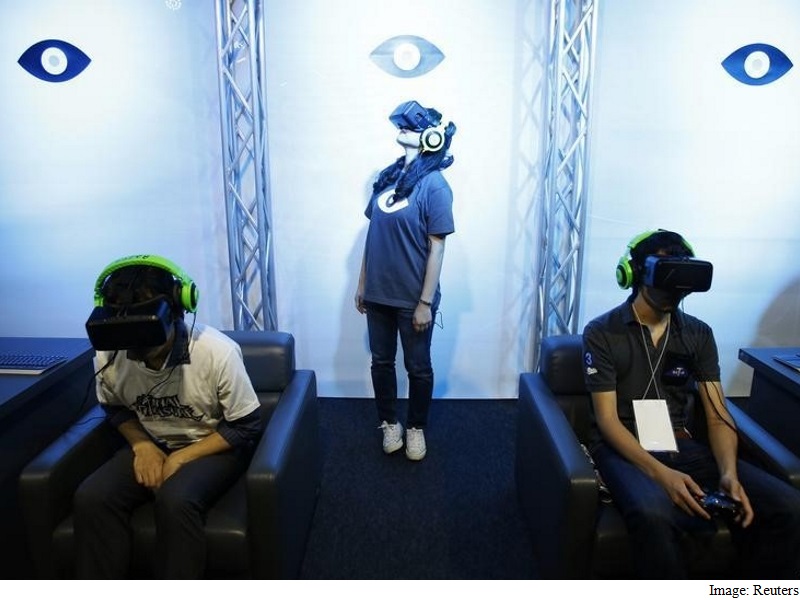- Home
- Wearables
- Wearables Opinion
- Virtual Reality Doesn't Have to Be Creepy. Really.
Virtual Reality Doesn't Have to Be Creepy. Really.

The trouble started with a picture from the Mobile World Congress of Facebook chief executive Mark Zuckerberg walking by a crowd of people seemingly lost in their own little virtual realities.
In that image, a lot of people saw shades of Aldous Huxley's "Brave New World" or even of "The Matrix":
That set off a wave of punditry and pontificating about how creepy virtual reality can be.
And that is completely understandable. Even as a person who really likes VR and all that it promises, I admit that one of the greatest weaknesses of virtual reality headsets are how they look from the outside. The fact that every person in that audience is missing the fact that Zuckerberg is walking past them compounds the image of virtual reality as an isolating activity. So does every cringe-inducing social media picture of people wearing them on the subway, oblivious to their fellow travelers and, presumably, also indifferent to getting off at the right stop.
But while it's easy to see a future of solitude, troubling escapism or the dominance of machines in the Mobile World Congress image, "The Matrix" wasn't my first thought when looking at that image. (Though it was, I admit, my second.)
I was immediately reminded of people watching a movie with 3D glasses. And there's a big difference. Read the first way, people are cut off from one another. In the second, they're collectively participating in a familiar activity in a novel way. (Though, yes, I admit that they still look even doofier than your average movie theater audience.) That's really exciting, at least to me. And, at least according to Zuckerberg, that's what's really happening in that photo - all of those people were watching a soccer game.
(Also see: Oculus Rift: Bringing Reality to the Virtual World)
There are still a lot of things to work out about virtual reality, of course. For one, it's not clear how adoption will actually work. Some people have suggested that movie theaters could be the way to get the mainstream into the technology, as a twist on the theater experience that gives people an on-ramp into the technology in an environment where it's already normal to sit with strangers and not talk to each other at all.
But there are some hiccups there to work out - namely, all of the logistics. "I think it's still really, really, early," said Patrick Corcoran, communications director at the National Association of Theatre Owners. Depending on the type of film being screened, attendees might want to walk around. Even if you're sitting down and watching, you could turn your head and collide with the person next to you. "The logistics of how to build an auditorium, how to keep people from bumping into each other - no one has figured how it would really work."
In my opinion, the best ways to use virtual reality won't be to have everyone attend an event, then all put on individual headsets to watch something else. The point is not to be alone together. It's to experience something new - maybe in a movie theater, sure, but more likely in your own living room.
It could even be a social tool of a kind, used to attend a concert, or experience what it'd be like to sit courtside at a sporting event for which you could never afford tickets. You could visit places you've never been, or walk through a real estate property you can't get to. As a person who's spent a lot of time very far away from my family - yes, I've even video-conferenced into holiday meals before - the thought that the technology exists to not only talk to my family members abroad but actually play a game of catch with them is pretty exciting.
Far from being a substitute for what you can do by walking outside of your door, at its best VR can be a tool for getting access to more of the world and staying in touch.
But people won't use things that don't make sense to them. We've seen that with products that have launched with lots of hype and then never quite taken hold. (Like, to be fair, 3D technology.) So if VR is to survive, it is incumbent on the industry, and on people who see the potential of it, to make it easy to use, easy to love, and - most importantly - indispensable enough to people to keep it going.
Plenty of devices have had to get over a certain creepy or dorky factor. Brick-like cellphones looked dumb. Earbuds seemed isolating. The camera cellphone seemed insane, even in 2004. If it works, people will come around.
Though . . . please. Stop wearing them on the subway. Ultimately, we may find people with VR headsets on trains as normal as your run-of-the-mill smartphone user with earbuds. For now, though, we're trying to win people over and you're making the rest of us look bad.
© 2016 The Washington Post
Catch the latest from the Consumer Electronics Show on Gadgets 360, at our CES 2026 hub.
Related Stories
- Samsung Galaxy Unpacked 2025
- ChatGPT
- Redmi Note 14 Pro+
- iPhone 16
- Apple Vision Pro
- Oneplus 12
- OnePlus Nord CE 3 Lite 5G
- iPhone 13
- Xiaomi 14 Pro
- Oppo Find N3
- Tecno Spark Go (2023)
- Realme V30
- Best Phones Under 25000
- Samsung Galaxy S24 Series
- Cryptocurrency
- iQoo 12
- Samsung Galaxy S24 Ultra
- Giottus
- Samsung Galaxy Z Flip 5
- Apple 'Scary Fast'
- Housefull 5
- GoPro Hero 12 Black Review
- Invincible Season 2
- JioGlass
- HD Ready TV
- Laptop Under 50000
- Smartwatch Under 10000
- Latest Mobile Phones
- Compare Phones
- Vivo Y500i
- OnePlus Turbo 6V
- OnePlus Turbo 6
- Itel Zeno 20 Max
- OPPO Reno 15 Pro Mini 5G
- Poco M8 Pro 5G
- Motorola Signature
- Vivo Y50e 5G
- Lenovo Yoga Slim 7x (2025)
- Lenovo Yoga Slim 7a
- Realme Pad 3
- OPPO Pad Air 5
- Xiaomi Watch 5
- Huawei Watch 10th Anniversary Edition
- Acerpure Nitro Z Series 100-inch QLED TV
- Samsung 43 Inch LED Ultra HD (4K) Smart TV (UA43UE81AFULXL)
- Asus ROG Ally
- Nintendo Switch Lite
- Haier 1.6 Ton 5 Star Inverter Split AC (HSU19G-MZAID5BN-INV)
- Haier 1.6 Ton 5 Star Inverter Split AC (HSU19G-MZAIM5BN-INV)

















